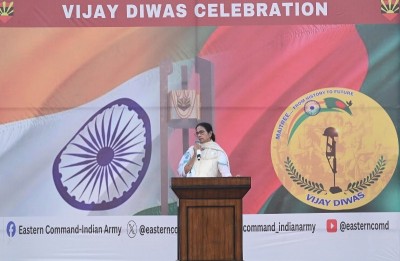 India
India
India ranks 39 in Global Innovation Index list, climbs up 42 spots in nine years
India has climbed a position to reach 39th place in the Global Innovation Index (GII) 2024 rankings, as per data released by the Geneva-based World Intellectual Property Organization.
The country ranked 40 in 2023.
Indian Minister Piyush Goyal acknowledged the development and posted on X: "India rises to 39th position among 133 global economies in the Global Innovation Index 2024!"
India rises to 39th position among 133 global economies in the Global Innovation Index 2024! 🇮🇳
— Piyush Goyal (@PiyushGoyal) September 26, 2024
Guided by PM @NarendraModi ji's decisive leadership, India achieves these remarkable milestones:
👉 1st among 10 economies in Central & Southern Asia
👉 1st among… pic.twitter.com/FbyE8JHJix
Switzerland, Sweden, the United States, Singapore and the United Kingdom are the world’s most-innovative economies, while China, Türkiye, India, Viet Nam and the Philippines1 are the fastest 10-year climbers, according to WIPO’s Global Innovation Index (GII) 2024, which shows a softening in venture capital activity, R&D funding and other investment indicators.
Now in its 17th edition, the GII is the world's benchmark resource charting global innovation trends to guide policy makers, business leaders and others in unleashing human ingenuity to improve lives and address shared challenges, like climate change.
This year, the GII also looks at “social entrepreneurship,” which uses private-sector practices for positive social change.
The 2024 edition identifies a major softening in leading indicators of future innovative activity, including a reversal of the 2020-2022 boom in innovation investments.
Amid higher interest rates, venture capital (VC) funding dropped by about 40 percent in 2023 and growth slipped in research and development (R&D) expenditures, while international patent filings and scientific publications fell.
In the GII ranking of 130-plus economies, China reached the 11th position and remains the only middle-income economy in the GII top 30.
A total of 19 economies outperformed on innovation relative to their level of development. India, the Republic of Moldova and Viet Nam are all innovation overperformers for 14 years in a row.
In more recent years, Saudi Arabia, Qatar, Brazil, Indonesia, Mauritius and Pakistan have climbed most in the GII (in order of their ranking). Indonesia, Pakistan and Uzbekistan maintain their overperformer status for a third year and Brazil for a fourth consecutive year.
Global leaders in innovation in 2024 – Regional Breakdown
Northern America
The United States holds stable in 3rd position. It scores best in the world in nine of the 78 GII 2024 innovation indicators, including in indicators global corporate R&D investors, unicorn valuation, intangible asset intensity, the quality of its universities, the impact of its scientific publications (H-index), software spending and intellectual property (IP) receipts.
Canada moves up to 14th place, its best rank since 2014. It leads in venture capital received and strategic alliances, while also ranking in the top 10 for its university–industry R&D collaboration, researchers working in the private sector and IP payments.
Europe
Europe still hosts the highest number of innovation leaders among the top 25 – 15 in total, with seven among the top 10. Out of the 39 European economies covered, only nine move up the ranking this year (10 fewer than last year): namely, Austria (17th), Ireland (19th) and Luxembourg (20th), Spain (28th), the Czech Republic (30th), Poland (40th), Croatia (43rd), Serbia (52nd), and Montenegro (65th).
Among economies that are improving, Austria excels in domestic industry diversification, production and export complexity, R&D expenditures, and public research–industry co-publications. In part influenced by the strong presence of foreign multinationals in the field of ICT, Ireland ranks top globally in ICT services exports and IP payments and ranks in the top three for its intangible asset intensity. Spain is performing well in software spending, industrial designs, and global corporate R&D investors.
Serbia gets closer to the top 50 with a strong performance in domestic industry diversification, ICT services exports, scientific and technical articles, and cultural and creative services exports.
South East Asia, East Asia, and Oceania
Seven South East Asia, East Asia and Oceania (SEAO) economies are world innovation leaders – one more than in 2023 – namely, Singapore (4th), the Republic of Korea (6th), China (11th), Japan (13th), Hong Kong, China (18th), Australia (23rd) and New Zealand (25th), which moves up two places.
Eleven economies within the SEAO region (out of 17 covered) improve their rankings this year, with Indonesia (54th) making the greatest advance and entering the top 60. Indonesia excels in university–industry R&D collaboration, policy stability for doing business and intangible asset intensity.
The Philippines goes up three ranks to reach the 53rd position. This year it has also attained 3rd position in the lower middle-income group. Notable areas in which it excels are trade-related indicators, including high-tech exports (1st globally), high-tech imports, creative goods exports and ICT services exports. It has also made advances, albeit at lower levels, in intangible assets, thanks to its strong global brand value– and the intangible asset intensity of its companies.
Thailand (41st) and Viet Nam (44th) continue to make advances towards the top 40. Malaysia (33rd) and Mongolia (67th) also move up the ranking.
Central and Southern Asia
In Central and Southern Asia, India (39th) continues to lead, moving one spot forward. The Islamic Republic of Iran (64th, down by two places) comes second, followed by Kazakhstan (78th). Uzbekistan (83rd) retains its 4th position within the region.
India leads the lower middle-income group. It holds the record for overperforming on innovation for the 14th consecutive year. India’s strengths lie in key indicators such as ICT services exports (at 1st place, globally), venture capital received and intangible asset intensity. India’s unicorn companies also secure the country the 8th rank globally.
Kazakhstan excels in government’s online service, utility models, e-participation and entrepreneurship policies and culture.
In addition to India and Kazakhstan, three other economies within the region move up the ranking: Sri Lanka (89th), Kyrgyzstan (99th) and Tajikistan (107th). Pakistan (91st) and Uzbekistan maintain their status as overperformers for a third consecutive year. Pakistan also positions itself among the economies that have shown the most significant ascent in the GII over the past five years.
Taking a longer-term view, all economies in the region have made sustained progress in their rankings over the past decade. Uzbekistan, the Islamic Republic of Iran, Pakistan, and India have made the largest advancements, in that order.
Northern Africa and Western Asia
Israel (15th), Cyprus (27th), the United Arab Emirates (32nd) and Türkiye (37th) lead in the innovation rankings for this region.
Despite moving down one rank this year, Israel leads in several key innovation indicators, ranking 1st globally in R&D expenditure, VC received, R&D performed by business, ICT services exports and unicorn valuation.
Türkiye continues to forge ahead, gaining two ranks. It also takes the 3rd position among the upper middle-income group. Türkiye stands out in various areas: it ranks 1st globally in trademarks and industrial designs, and 9th in intangible asset intensity – all showing an improvement this year.
Saudi Arabia (47th) and Qatar (49th) move ahead one spot each, consolidating their positions in the top 50. Georgia moves up to 57th place, followed by Armenia (63rd) and Morocco (66th).
Morocco ranks 1st globally in industrial designs and ranks in the top 30 on expenditure on education, intangible asset intensity, gross capital formation, high-tech manufacturing and trademarks.
Latin America and the Caribbean
In Latin America and the Caribbean, the regional top 3 remains unchanged: Brazil (50th) retains the top position, followed by Chile (51st) and Mexico (56th). Chile and Mexico improve their positions by one and two ranks, respectively.
Chile holds top positions in tertiary enrolment, market capitalization and foreign direct investment (FDI) net inflows. Mexico comes top in trade and high-tech indicators, including creative goods exports, high-tech exports, high-tech imports and high-tech manufacturing.
Seven additional economies within the region also improved their ranking: Colombia (61st), Paraguay (93rd), Uruguay (62nd), Costa Rica (70th), Peru (75th), Panama (82nd) and Honduras (114th).
Colombia ranks 18th globally for the valuation of its unicorn companies. It also leads in IP payments and high-tech imports.
Barbados rejoins the GII in 2024 at the 77th position, leading globally (1st) in patent families and WIPO Patent and Cooperation Treaty (PCT) patents, and performing in the top 20 in patents by origin and VC recipients. This year, Brazil and Jamaica (79th) continue to perform above expectation for their level of development.
Sub-Saharan Africa
In Sub-Saharan Africa, Mauritius (55th) leads the region, followed by South Africa (69th), Botswana (87th), Cabo Verde (90th) and Senegal (92nd). Eight of the region’s economies move up the GII ranking, including Mauritius, Cabo Verde, Senegal, Kenya (96th), Zambia (116th), Benin (119th), Mauritania (126th) and Burundi (127th).
Mauritius leads worldwide in VC received (1st) and ranks 2nd in VC investors. Cabo Verde ranks 1st in gross capital formation, while South Africa performs well in ICT services imports and global brand value. Senegal excels in gross capital formation, unicorn valuation, loans from microfinance institutions, FDI net inflows and VC received.
Kenya gains 4 ranks and performs well in VC recipients, utility models, ICT services exports and labor productivity growth. Madagascar (110th) performs well in industrial designs and trademarks, both of which show improvement this year.
Burundi, Madagascar, Rwanda (104th), Senegal and South Africa are also innovation overperformers this year, with Rwanda’s period of overperformance lasting longest, at 12 years. Rwanda leads the low-income group, followed by Madagascar and Togo (117th).
Support Our Journalism
We cannot do without you.. your contribution supports unbiased journalism
IBNS is not driven by any ism- not wokeism, not racism, not skewed secularism, not hyper right-wing or left liberal ideals, nor by any hardline religious beliefs or hyper nationalism. We want to serve you good old objective news, as they are. We do not judge or preach. We let people decide for themselves. We only try to present factual and well-sourced news.







